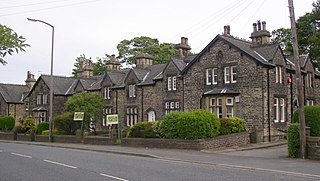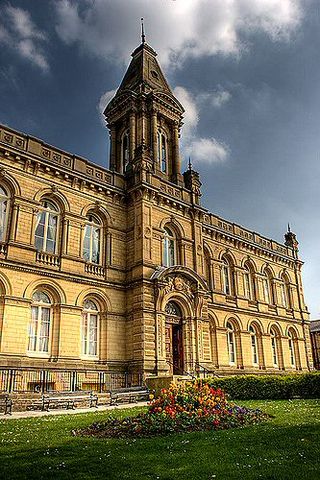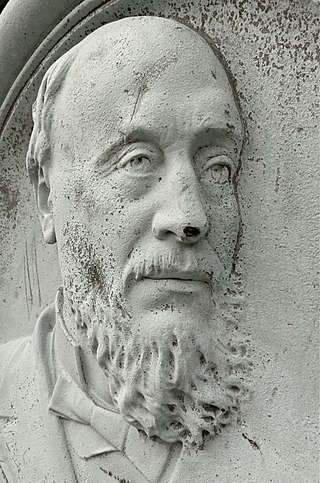
Sir Titus Salt, 1st Baronet was a manufacturer, politician and philanthropist in Bradford, West Riding of Yorkshire, England, who is best known for having built Salt's Mill, a large textile mill, together with the attached village of Saltaire, West Yorkshire.

Saltaire is a Victorian model village in Shipley, West Yorkshire, England, situated between the River Aire, the railway, and the Leeds and Liverpool Canal. Salt's Mill and the houses were built by Titus Salt between 1851 and 1871 to allow his workers to live in better conditions than the slums of Bradford. The mill ceased production in 1986, and was converted into a multifunctional location with an art gallery, restaurants, and the headquarters of a technology company. It is a UNESCO World Heritage Site and on the European Route of Industrial Heritage.

Shipley is a historic market town and civil parish in the City of Bradford, West Yorkshire, England, by the River Aire and the Leeds and Liverpool Canal, north of Bradford. The population of the Shipley ward on Bradford City Council taken at the 2011 Census was 15,483.

Baildon is a town and civil parish in the Bradford Metropolitan Borough in West Yorkshire, England and within the historic boundaries of the West Riding of Yorkshire.

Salts Mill is a former textile mill, now an art gallery, shopping centre, and restaurant complex in Saltaire, Bradford, West Yorkshire, England. It was built by Sir Titus Salt in 1853, and the present-day 1853 Gallery takes its name from the date of the building which houses it. The mill has many paintings by the local artist David Hockney on display and also provides offices for Pace plc.

Lightcliffe is a village in the Calderdale district in West Yorkshire, England. Historically part of the West Riding of Yorkshire, it is situated approximately three miles east of Halifax and two miles north west of Brighouse. Lightcliffe was a separate parish in 1846 in the West Riding of Yorkshire.

Henry Francis Lockwood was an influential English architect active in the North of England.

St Leonards-on-Sea Congregational Church is a former Congregational church in St Leonards-on-Sea, part of the town and borough of Hastings in East Sussex, England. Considered "one of the most ambitious Nonconformist buildings in Sussex", the sandstone building of 1863 forms a significant landmark on one of the Victorian resort's main roads—despite the loss of its copper spire in the Great Storm of 1987. Unlike most churches of its denomination, it did not join the United Reformed Church when that denomination was formed in 1972. It fell out of religious use in 2008 and had stood empty and was at risk of demolition. English Heritage has listed the building at Grade II for its architectural and historical importance. Bought by a new owner in 2012 it was almost completely renovated, but was then sold again in 2019. The new owner plans to open the church to the public as an arts and antiques centre with a cafe in the tower.

Roberts Park is a 14 acres (5.7 ha) public urban park in Saltaire, West Yorkshire, England. Higher Coach Road, Baildon, is to the north and the park is bounded to the south by the River Aire. A pedestrian footbridge crosses the Aire and links the park to the village of Saltaire. The park is an integral part of the Saltaire World Heritage site.

West Yorkshire is a metropolitan county in the Yorkshire and the Humber region of England. Created as a metropolitan county in 1974 after the passage of the Local Government Act 1972, it consists of five metropolitan boroughs, namely the City of Bradford, Calderdale, Kirklees, the City of Leeds and the City of Wakefield. Its area corresponds approximately with the historic West Riding of Yorkshire, and it contains the major towns of Bradford, Dewsbury, Halifax, Huddersfield, Leeds, and Wakefield.

Victoria Hall, Saltaire is a Grade II* listed building in the village of Saltaire, near Bradford, West Yorkshire, England, built by architects Lockwood and Mawson.

William Mawson was an English architect best known for his work in and around Bradford.
Benjamin Burstall was a sculptor, architectural sculptor and stone carver, based in Leeds, West Riding of Yorkshire, England.

Headingley Hill Congregational Church is a redundant Unitarian church at the corner of Headingley Lane and Cumberland Road, in the Headingley area of Leeds, West Yorkshire, England. The church, which is a Grade II listed building, was designed in the Gothic Revival style by Cuthbert Brodrick and completed in 1866. It was the only church to have been designed by Brodrick, who is noted for Leeds Town Hall and the Corn Exchange.

Albemarle Baptist Church is a Grade II listed church located on Albemarle Crescent, central Scarborough, North Yorkshire, England. It was designed in the Gothic Revival style by the Bradford architect Henry Francis Lockwood, and opened in 1867.

The Weybridge United Reformed Church situate at Queen's Road, Weybridge, near to its junction with York Road, is a Victorian Grade II Listed church building that is now no longer used as a place of worship.
Saltaire is a model village in Shipley, a ward in the metropolitan borough of the City of Bradford, West Yorkshire, England. The village contains 93 listed buildings that are recorded in the National Heritage List for England. Of these, one is listed at Grade I, the highest of the three grades, four are at Grade II*, the middle grade, and the others are at Grade II, the lowest grade. In 1850 Titus Salt started to build a textile mill, known as Salt's Mill, alongside the Leeds and Liverpool Canal and then developed the model village to house and serve its workers. This included housing, shops, and community buildings, all of which are listed. The architects for the entire scheme, including later mills, were the Bradford architects Lockwood and Mawson. All the listed buildings built between 1850 and 1870 were designed by them. The later listed buildings are a tram shed, a war memorial and a telephone kiosk.
Shipley is a ward in the metropolitan borough of the City of Bradford, West Yorkshire, England. Excluding the listed buildings in the model village of Saltaire, which are the subject of a separate list, it contains 14 listed buildings that are recorded in the National Heritage List for England. Of these, one is at Grade II*, the middle of the three grades, and the others are at Grade II, the lowest grade. The listed buildings consist of a farmhouse and a barn, houses, churches and associated structures, a canal bridge and a warehouse, mill buildings, including a chimney, and a war memorial.

Milner Field was a large country house near Saltaire in West Yorkshire, England built in 1872 for Titus Salt Junior, youngest son of the Yorkshire wool merchant and philanthropist Sir Titus Salt and demolished in the 1950s. The house was situated at the edge of the village of Gilstead, near Bingley, overlooking the Aire Valley in the direction of Salt senior's model village of Saltaire and Salts Mill.

Christchurch, Ilkley is a Grade II listed United Reformed and Methodist ecumenical partnership church in Ilkley, North Yorkshire, England.



















